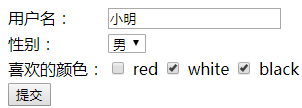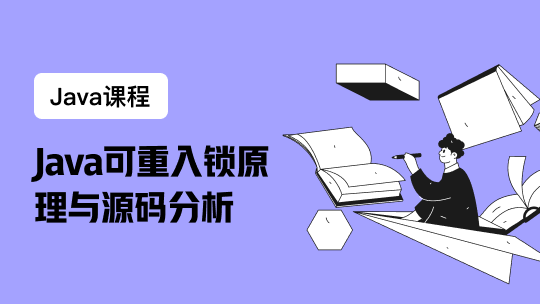Spring Boot中Thymeleaf对表单处理的一些用法:
(1)使用th:field属性:进行表单字段绑定
(2)使用ids对象:一般用于lable配合radio或checkbox使用
(3)表单提交处理
开发环境:IntelliJ IDEA 2019.2.2
Spring Boot版本:2.1.8
新建一个名称为demo的Spring Boot项目。
pom.xml 依赖项如下:
<dependency>
<groupId>org.springframework.boot</groupId>
<artifactId>spring-boot-starter-web</artifactId>
</dependency>
<dependency>
<groupId>org.springframework.boot</groupId>
<artifactId>spring-boot-starter-thymeleaf</artifactId>
</dependency>
<dependency>
<groupId>org.springframework.boot</groupId>
<artifactId>spring-boot-devtools</artifactId>
</dependency>
一、使用th:field属性
th:field属性常用于表单字段绑定,除了自动生成id和name属性,对不同的节点类型还会有不同的生成逻辑。
例如input还会再生成value属性,textarea会自动设文本,select会自动选中相应的选项,如果是同个表单属性,radio和checkbox的id会全局自动增长。
备注:
(1)使用th:field属性时,如果html节点中已经存在相应属性,则不会再另外生成。
(2)th:field属性需要使用星号表达式*{...},即先使用th:object声明表单对象,再使用th:field=*{...}对表单域进行处理。
1、src/main/java/com/example/demo/User.java
package com.example.demo;
public class User {
String name;
Integer sex;
String[] MyColors;
public String getName() {
return name;
}
public void setName(String name) {
this.name = name;
}
public Integer getSex() {
return sex;
}
public void setSex(Integer sex) {
this.sex = sex;
}
public String[] getMyColors() {
return MyColors;
}
public void setMyColors(String[] myColors) {
MyColors = myColors;
}
}
2、src/main/java/com/example/demo/FieldController.java
package com.example.demo;
import org.springframework.stereotype.Controller;
import org.springframework.ui.Model;
import org.springframework.web.bind.annotation.RequestMapping;
import java.util.HashMap;
import java.util.Map;
@Controller
public class FieldController {
@RequestMapping("/field")
public String field(Model model){
//设置用户对象
User user = new User();
user.setName("小红");
user.setSex(0);
model.addAttribute("user", user);
//设置性别
Map<String, Object> sexes = new HashMap<String, Object>();
sexes.put("男", 1);
sexes.put("女", 0);
model.addAttribute("sexes", sexes);
return "field";
}
}
3、src/main/resources/templates/field.html
<!DOCTYPE html>
<html>
<head>
<meta charset="UTF-8">
<title>使用th:field属性</title>
</head>
<body>
<form th:object="${user}">
<input type="text" th:field="*{name}" id="name1" />
<input type="text" th:field="*{name}" />
<input type="text" th:field="*{name}" />
<textarea th:field="*{name}"></textarea>
<textarea th:field="*{name}"></textarea>
<select th:field="*{sex}">
<option th:each="sex : ${sexes}" th:value="${sex.value}" th:text="${sex.key}"></option>
</select>
<select th:field="*{sex}">
<option th:each="sex : ${sexes}" th:value="${sex.value}" th:text="${sex.key}"></option>
</select>
<input type="checkbox" th:field="*{name}" value="*{name}"/>
<input type="checkbox" th:field="*{name}" value="*{name}"/>
<input type="radio" th:field="*{name}" value="*{name}"/>
<input type="radio" th:field="*{name}" value="*{name}"/>
</form>
</body>
</html>
启动服务后,浏览器访问http://localhost:8080/field,网页源代码如下:
<!DOCTYPE html>
<html>
<head>
<meta charset="UTF-8">
<title>使用th:field属性</title>
</head>
<body>
<form>
<input type="text" id="name1" name="name" value="小红" />
<input type="text" id="name" name="name" value="小红" />
<input type="text" id="name" name="name" value="小红" />
<textarea id="name" name="name">小红</textarea>
<textarea id="name" name="name">小红</textarea>
<select id="sex" name="sex">
<option value="0" selected="selected">女</option>
<option value="1">男</option>
</select>
<select id="sex" name="sex">
<option value="0" selected="selected">女</option>
<option value="1">男</option>
</select>
<input type="checkbox" value="*{name}" id="name1" name="name"/><input type="hidden" name="_name" value="on"/>
<input type="checkbox" value="*{name}" id="name2" name="name"/><input type="hidden" name="_name" value="on"/>
<input type="radio" value="*{name}" id="name3" name="name"/>
<input type="radio" value="*{name}" id="name4" name="name"/>
</form>
</body>
</html>
二、使用ids对象
可以使用ids对象的seq方法生成指定名称的递增id。
对于radio和checkbox自动生成的id,配合lable节点使用时,需要知道这个id,可以使用ids对象的prev和next方法。
1、src/main/java/com/example/demo/IdsController.java
package com.example.demo;
import org.springframework.stereotype.Controller;
import org.springframework.ui.Model;
import org.springframework.web.bind.annotation.RequestMapping;
@Controller
public class IdsController {
@RequestMapping("/ids")
public String ids(Model model){
User user = new User();
user.setName("小红");
user.setSex(0);
model.addAttribute("user", user);
return "ids";
}
}
2、src/main/resources/templates/ids.html
<!DOCTYPE html>
<html>
<head>
<meta charset="UTF-8">
<title>使用ids对象</title>
</head>
<body>
<form th:object="${user}">
<input type="text" th:field="*{name}" th:id="${#ids.seq('tname')}" />
<input type="text" th:field="*{name}" th:id="${#ids.seq('tname')}" />
<input type="radio" th:field="*{name}" value="*{name}" th:id="${#ids.seq('rname')}"/>
<input type="radio" th:field="*{name}" value="*{name}" th:id="${#ids.seq('rname')}"/>
<input type="checkbox" th:field="*{name}" value="*{name}" th:id="${#ids.seq('cname')}" />
<input type="checkbox" th:field="*{name}" value="*{name}" th:id="${#ids.seq('cname')}"/>
<input type="radio" th:field="*{name}" value="*{name}" />
<label th:for="${#ids.prev('name')}" th:text="单选A"></label>
<input type="radio" th:field="*{name}" value="*{name}" />
<label th:for="${#ids.prev('name')}" th:text="单选B"></label>
<label th:for="${#ids.next('name')}" th:text="多选A"></label>
<input type="checkbox" th:field="*{name}" value="*{name}" />
<label th:for="${#ids.next('name')}" th:text="多选B"></label>
<input type="checkbox" th:field="*{name}" value="*{name}" />
</form>
</body>
</html>
启动服务后,浏览器访问http://localhost:8080/ids,网页源代码如下:
<!DOCTYPE html>
<html>
<head>
<meta charset="UTF-8">
<title>使用ids对象</title>
</head>
<body>
<form>
<input type="text" id="tname1" name="name" value="小红" />
<input type="text" id="tname2" name="name" value="小红" />
<input type="radio" value="*{name}" id="rname1" name="name"/>
<input type="radio" value="*{name}" id="rname2" name="name"/>
<input type="checkbox" value="*{name}" id="cname1" name="name" /><input type="hidden" name="_name" value="on"/>
<input type="checkbox" value="*{name}" id="cname2" name="name"/><input type="hidden" name="_name" value="on"/>
<input type="radio" value="*{name}" id="name1" name="name" />
<label for="name1">单选A</label>
<input type="radio" value="*{name}" id="name2" name="name" />
<label for="name2">单选B</label>
<label for="name3">多选A</label>
<input type="checkbox" value="*{name}" id="name3" name="name" /><input type="hidden" name="_name" value="on"/>
<label for="name4">多选B</label>
<input type="checkbox" value="*{name}" id="name4" name="name" /><input type="hidden" name="_name" value="on"/>
</form>
</body>
</html>
三、表单的提交处理
提交后,在控制器方法中使用@ModelAttribute映射表单对象。
1、src/main/java/com/example/demo/FormController.java
package com.example.demo;
import org.springframework.stereotype.Controller;
import org.springframework.ui.Model;
import org.springframework.web.bind.annotation.ModelAttribute;
import org.springframework.web.bind.annotation.PostMapping;
import org.springframework.web.bind.annotation.RequestMapping;
import java.util.Arrays;
import java.util.HashMap;
import java.util.Map;
@Controller
public class FormController {
@RequestMapping("/form")
public String form(Model model){
setConstant(model);
User user = new User();
user.setName("小明");
user.setSex(1);
user.setMyColors(new String[]{"white", "black"});
model.addAttribute("user", user);
return "form";
}
@PostMapping("/submit")
public String submit(@ModelAttribute User user, Model model){
setConstant(model);
model.addAttribute("user", user);
System.out.println("姓名:" + user.getName());
System.out.println("性别:" + (user.getSex().intValue() == 1 ? "男" : "女"));
System.out.println("喜欢的颜色:" + Arrays.toString(user.getMyColors()));
//return "redirect:/form";
return "form";
}
//设置常量
private void setConstant(Model model){
Map<String, Object> sexes = new HashMap<String, Object>();
sexes.put("男", 1);
sexes.put("女", 0);
model.addAttribute("sexes", sexes);
String[] colors = new String[]{"red", "white", "black"};
model.addAttribute("colors", colors);
}
}
2、src/main/resources/templates/form.html
<!DOCTYPE html>
<html>
<head>
<meta charset="UTF-8">
<title>表单的提交处理</title>
</head>
<body>
<form method="post" th:action="@{/submit}" th:object="${user}">
<table>
<tr>
<td>用户名:</td>
<td><input type="text" th:field="*{name}" /></td>
</tr>
<tr>
<td>性别:</td>
<td><select th:field="*{sex}">
<option th:each="sex : ${sexes}" th:value="${sex.value}" th:text="${sex.key}"></option>
</select>
</td>
</tr>
<tr>
<td>喜欢的颜色:</td>
<td>
<span th:each="color : ${colors}">
<input type="checkbox" th:field="*{myColors}" th:value="${color}" />
<label th:for="${#ids.prev('myColors')}" th:text="${color}"></label>
</span>
</td>
</tr>
<tr>
<td colspan="2">
<input type="submit" value="提交" />
</td>
</tr>
</table>
</form>
</body>
</html>
启动服务后,浏览器访问http://localhost:8080/from,页面如下图:

网页源代码如下:
<!DOCTYPE html>
<html>
<head>
<meta charset="UTF-8">
<title>表单的提交处理</title>
</head>
<body>
<form method="post" action="/submit">
<table>
<tr>
<td>用户名:</td>
<td><input type="text" id="name" name="name" value="小明" /></td>
</tr>
<tr>
<td>性别:</td>
<td><select id="sex" name="sex">
<option value="0">女</option>
<option value="1" selected="selected">男</option>
</select>
</td>
</tr>
<tr>
<td>喜欢的颜色:</td>
<td>
<span>
<input type="checkbox" value="red" id="myColors1" name="myColors" /><input type="hidden" name="_myColors" value="on"/>
<label for="myColors1">red</label>
</span><span>
<input type="checkbox" value="white" id="myColors2" name="myColors" checked="checked" /><input type="hidden" name="_myColors" value="on"/>
<label for="myColors2">white</label>
</span><span>
<input type="checkbox" value="black" id="myColors3" name="myColors" checked="checked" /><input type="hidden" name="_myColors" value="on"/>
<label for="myColors3">black</label>
</span>
</td>
</tr>
<tr>
<td colspan="2">
<input type="submit" value="提交" />
</td>
</tr>
</table>
</form>
</body>
</html>
点击提交按钮,IDEA控制台输出:
姓名:小明
性别:男
喜欢的颜色:[white, black]













